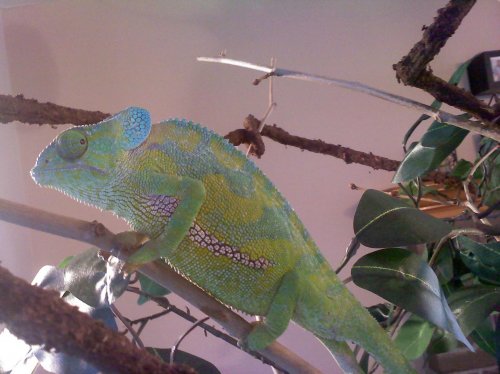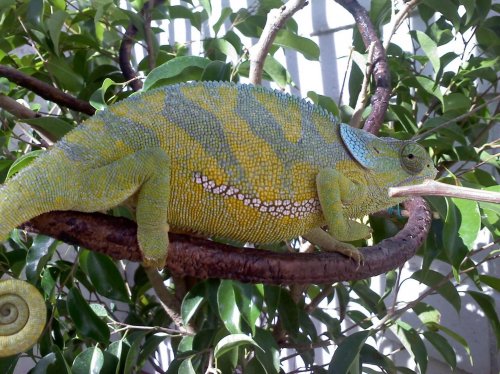Navigation
Install the app
How to install the app on iOS
Follow along with the video below to see how to install our site as a web app on your home screen.
Note: This feature may not be available in some browsers.
More options
You are using an out of date browser. It may not display this or other websites correctly.
You should upgrade or use an alternative browser.
You should upgrade or use an alternative browser.
help identify
- Thread starter houseofchameleons
- Start date
Kent67
Retired Moderator
Wow, that is a beauty! If I remember correctly, this group came from Malawi. If from the southern highlands it would be Chamaeleo dilepis isabellinus or Chamaeleo dilepis "isabellinus form," depending on who you ask. The photos I have of that taxa have similar patterns but are not as colorful.
Cainschams
New Member
WOW!!! That is one stunning flapper!!!!!
houseofchameleons
New Member
Thankyou his blue also goes to purple , his greens go yellow & his stripe goes pink...He is also a very sweet cham. When we got him he was shy & just liked to be left alone but now that we have handled him he likes to sit in your hand
Ferdy Timmerman
Member
Don't know too much about the differences between the dilepis-like species, but I find this animal has rather large occipital lobes. The photo's I have of Ch. dilepis isabellinus show animals with smaller lobes. My guess would be dilepis dilepis. By the way, I wouldn't be too sure your chameleon is a "he". Male dilepis have a tarsal spur on their hind feet. Did you get your cham from a wildcaught shipment? Wouldn't surprise me if you'd have a pregnant female...
okiroo
Avid Member
Don't know too much about the differences between the dilepis-like species, but I find this animal has rather large occipital lobes. The photo's I have of Ch. dilepis isabellinus show animals with smaller lobes. My guess would be dilepis dilepis. By the way, I wouldn't be too sure your chameleon is a "he". Male dilepis have a tarsal spur on their hind feet. Did you get your cham from a wildcaught shipment? Wouldn't surprise me if you'd have a pregnant female...
i agree, looks like a she thats very gravid
Captive Creations
Member
I agree to with him being a female. I didnt see any tarsal spurs. I would have to say female as well. and she is beautiful too by the way. great colours
Miss Lily
Chameleon Enthusiast
Oh dear, Ginger! Looks like you may have your first female. She does look quite female in the body shape department in those pics. Males of all species tend to be longer bodied. What a bargain though, eh?! If Rigley is a girl then you will have lots of chameleons for the price of one! Sounds brilliant to me, lol!
Sounds brilliant to me, lol!
houseofchameleons
New Member
I was told at the time of purchase that since this was one of a more rare type flapneck that he doesn't have heel spurs along with the blue lobes. I was also told by 3 other people that it was male & 1 of them happened to be a very respected reptile vet that happened to be at the show.He/she has not been doing any digging but I guess time will tell
Ferdy Timmerman
Member
I'm not 100% sure. Like I said, I don't know all the differences between the dilepis like (sub)species. I've never kept any of them, so I have to judge based on photo's and information I find in reliable books, and compare that to two photo's of an unknown animal.
It's true that sexual dimorphism differs between (sub)species, so no tarsal spurs doesn't have to mean it is definetely not a male. Maybe someone with more dilepis-knowledge can take a look at your photo's
By the way, in Tilbury's Chameleons of Africa (2010), there are photo's of dilepis "angusticoronatus" and dilepis isabellinus that have blue lobes, and there's also a photo with another dilepis with blue lobes, but there's no name other than Chamaeleo dilepis below that photo. Could be the 'normal' form.
I'd be happy with this animal anyway. I don't think I've ever seen a better looking dilepis!
It's true that sexual dimorphism differs between (sub)species, so no tarsal spurs doesn't have to mean it is definetely not a male. Maybe someone with more dilepis-knowledge can take a look at your photo's
By the way, in Tilbury's Chameleons of Africa (2010), there are photo's of dilepis "angusticoronatus" and dilepis isabellinus that have blue lobes, and there's also a photo with another dilepis with blue lobes, but there's no name other than Chamaeleo dilepis below that photo. Could be the 'normal' form.
I'd be happy with this animal anyway. I don't think I've ever seen a better looking dilepis!
Ferdy Timmerman
Member
Forgot to mention that the animal in the photo seems to lack hemipenal bulges on the tail base. Another indication of it being a female. Maybe you could try to gently palpate her belly in order to check if she(?) indeed has eggs?
houseofchameleons
New Member
I am happy either way...Rigley is a sweet cham & I did palpate but felt nothing
Damaranum
Established Member
This is really difficult and based on any literature I've read I wouldn't dear to even guess which subspecies this is. Do you have any clue from which country this animal was imported.
I have to agree with Ferdy that this animal looks more as a female. It's true that their are several subspecies where males don't have spurs. But normally males do have a hemipenal buldge and this one is really lacking.
Although I can't give you and advise 1 thing is sure this is a beautiful specimen!
I have to agree with Ferdy that this animal looks more as a female. It's true that their are several subspecies where males don't have spurs. But normally males do have a hemipenal buldge and this one is really lacking.
Although I can't give you and advise 1 thing is sure this is a beautiful specimen!
houseofchameleons
New Member
Thanks Carol but like I said before I am sure its a male.I have very reliable sources with experience in flaps & really all I wanted to know was the subspecies but it seems like whenever you come on the forum with a concern or question there is always too many other opinions that make you second guess what you believe.
Similar threads
- Replies
- 0
- Views
- 113







